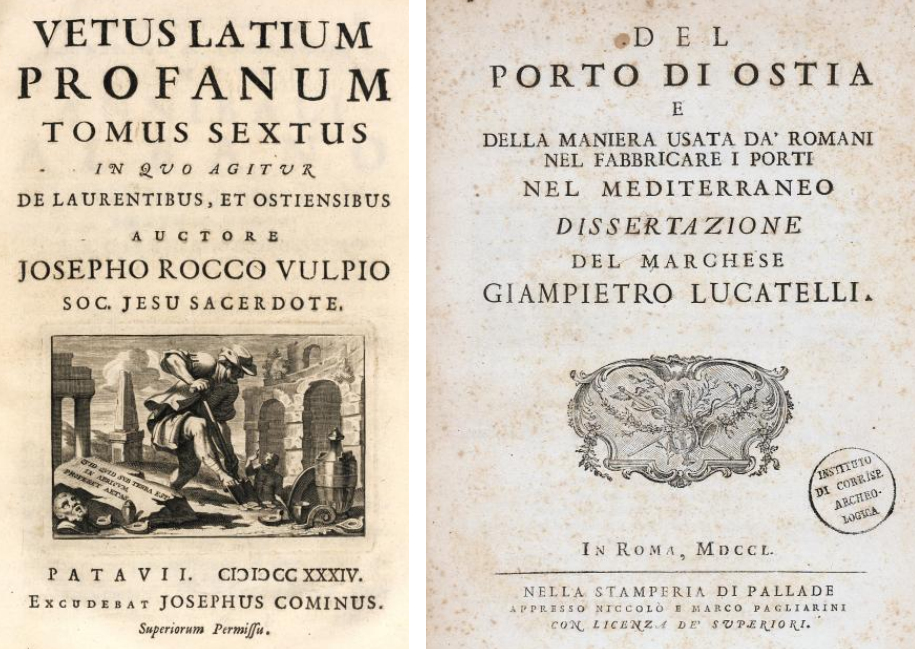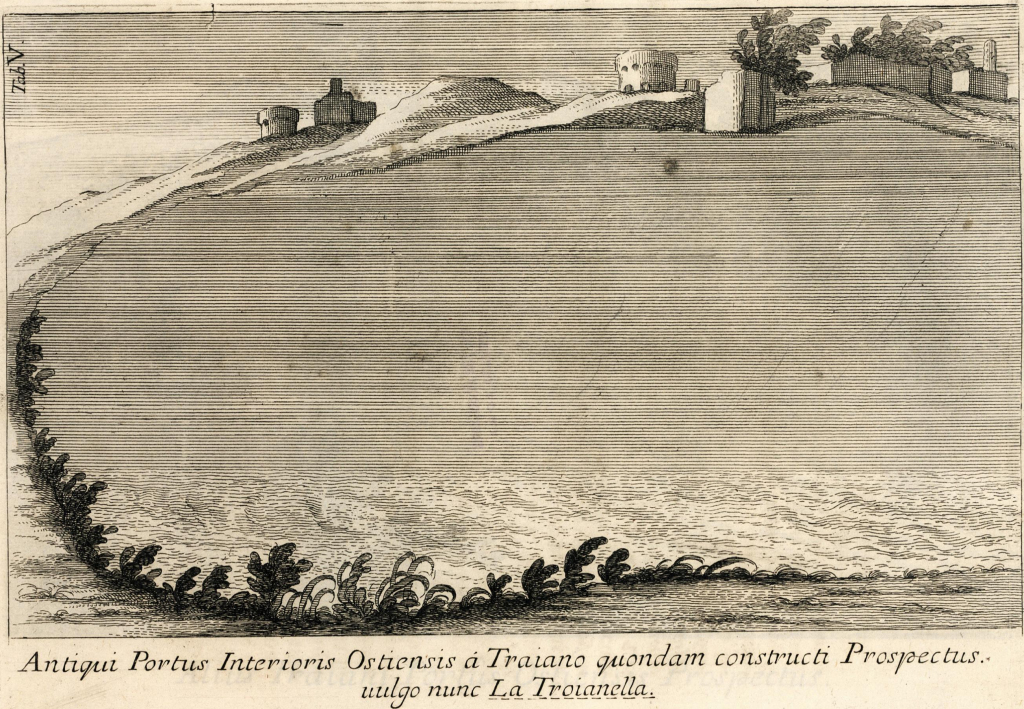THE 17th AND 18th CENTURY
For some reason we have hardly any information from the 17th and most of the 18th century. In 1699 the Dutch author Hendrik Doedyns reported the following: "A certain farmer in Ostia, who had found an old coin of gold, was taken into custody, to know whether he has not found more. Thus he became unhappy through his luck. Since then, no one wanted to dig or excavate there anymore. The yokels run away from it, like the Devil from the Cross.".[1] But looking for ancient treasures and earn some money with it would not be forbidden for everyone. In the 17th century actual permits were given for excavations. Usually we only hear of the year in which the work took place: 1621, 1629, 1696, 1732, 1740, 1750. Incidentally a relief or a statue is mentioned. Starting in 1772 the work intensified, permission was given to many people to excavate. We witness a confusing search for antiquities - statues, portraits, sarcophagi and inscriptions. The popes, who owned part of the territory, stimulated the work. Antiquarians, sculptors and art merchants were involved, from Italy and from abroad. The excavators often sold their discoveries, or gave them away as presents. Aristocratic families were active in specific areas: Torlonia in Portus, Aldobrandini in Ostia, Chigi in the area to the south of Ostia. They started private collections in their palazzi.
In 1734 and 1750 the first lengthy studies of Ostia and Portus were published. Giuseppe Rocco Volpi, a Jesuit, wrote (in Latin) about Ostia, Portus, and the area to the south of Ostia, the ager Laurens. The work includes engravings of Portus and works of art. Marquis Giampietro Lucatelli wrote about Portus, arguing that the hexagonal basin depicted on coins of Trajan was a depiction of the harbour of Centumcellae - Civitavecchia.


A harbour basin in Portus in the early 18th century. Volpi 1734, Tav. V.
As to the excavations: we should not be thinking of slow, stratigraphic research. Promising treasure groves were easily identified: the higher the hills concealing ruins, the more important the buildings, and the greater the chance to find objects. From the descriptions the impression emerges of more than just digging holes: entire buildings were emptied and filled with earth again. Sometimes we hear the excavators complain that an area has already been searched thoroughly by others, most likely also digging up many bricks.
We hear of excavations to the south of Ostia, the Castelfusano - Castelporziano area. Many villas had been built here, especially at Tor Paterno. In the years 1777-1780 a later owner of Castelfusano, prince Sigismondo Chigi, got permission from his neighbour the Baron del Nero of Castelporziano to excavate at Tor Paterno. Many valuable marbles were found: portraits, statues, columns, capitals, marble vases, reliefs and paintings, furthermore small finds, such as coins and cameos, and a vast quantity of lead (obviously water pipes). In 1783 Pope Pius VI ordered more excavations at Tor Paterno, and again the search was fruitful. The objects and their inventory were inspected in a Chigi palazzo by Ennio Quirino Visconti, responsible for collections in the Museo Pio-Clementino and Capitoline Museums. Already there was confusion. Some objects are missing, others have been taken to the Capitoline museums, still others do not match the description.
In the years 1772-1779 the Scottish painter Gavin Hamilton was active at several spots: to the south of Ostia, in Ostia itself especially near the Marine Gate, and in Portus. In 1772 he wrote: "I have had a run of bad luck at late, particularly at the Ports of Trajan and Claudius, where I have found nothing". In 1775 he wrote the following to his patron Charles Townley, discussing excavations in the Baths of the Marine Gate (IV,X,1-2) and the Maritime Baths (III,VIII,2):
|
"Being desirous of trying my fortune somewhere near the sea, I agreed with Cardinal Serbelloni, then Bishop of that place, who granted me liberty to make some trials in that immense field of antiquity. I got as near the Sea as possible, judging it the most probable place to find objects of taste. We opened ground on a spot now called Porta Marina. From the figure of the ruins they proved to be the remains of publick Thermae Maritimae, and from the inscriptions which were found of an unusual size, it seems those Baths had been restored by different Emperors down to Constantin. I gave a very elegant one of the time of Trajan to Carlo Albagine, but what gave me greatest hopes was to find some marks of my friend Hadrian, the great protectour of fine arts and in particular that of Sculptour. I did not remain long in suspense, for the first Statue that was brought to light was the fine Antinous in the character of Abundance, perhaps the finest of that subject in the world. Mr. Bary tells me it is arrived safe at his house in England, and where I hope by this time you have had the pleasure to consider it. Near this Statue was found a very indifferent one of an Esculapius, and a large statue of his daughter Hygea, very entire, and of a great deal of merit; this Statue was sold with some other pieces of good sculptour to the Langrave of Hesse Cassel. We found next a most excellent Torso under the knees, of which there is a duplicate at the Capitol." "Little more of consequence was found at Porta Marina, as I found that others had been there before me, so we proceeded to another Ruin on the sea shore, which from some fragments found above ground gave great hopes. A Bath was first discovered with the pavement of Verd antique and a fine Torso of a young man of which most of the other parts were found much broke, excepting the Head, notwithstanding the greatest diligence made for so interesting a discovery. The present Pope Pius VIth has ordered it to be restored for the Museum. Your small Venus holding a mirror is another of the precious ornaments of this Bath; four of the Labours of Hercules were found at some little distance from this place, which being very entire, and with their proper emblems, now add to the lustre of the Pope's Museum, to which I may add that tasty Tripod of Apollo, found near where we discovered your Mother of Venus and Muse, which, as they are in every respect two of my happiest discoveries, I am very happy that they should fall into so good hands as your own, especially as they make part of those select pieces of art which I hope will in time establish a good taste in England." |

A painting of Charles Townley in his sculpture gallery (Johann Zoffani, 1782). Photo: Wikimedia.
In this period permits for work in the quarries, as they were called ("cave"), were given by cardinal Albani, the bishop of Ostia. In 1773 prince Altieri and Thomas Jenkins, a British antiquarian, set up an "Association for Excavating the Tiber", the work of which was of course not restricted to the river. They were competitors of Hamilton. In 1779-1780 Giovanni Volpato, an art dealer, and Thomas Jenkins found two mosaics, which were sold to Saint Petersburg (Townley was not interested in mosaics). In 1783 the House of the Dolia to the west of the Cardo (near I,XIX) was excavated by Diego di Norogna, a minister from Portugal, and abbot Montanari. Sixteen of the enormous storage jars (dolia) were bought by principe Chigi and now adorn the Castello Chigi (also called Villa Chigi-Sacchetti) at Castel Fusano as flower pots, and, in Rome, the Villa Borghese and Villa Negroni. In the years 1788-1798 Venceslao Pezolli, a papal inspector, dug up inscriptions. In 1794 padre Giovanni Maria Cassini was digging in Portus. He found a colossal statue of Trajan that once overlooked the hexagonal basin. From 1794 to 1801 the English painter of Irish descent Robert Fagan searched succesfully for treasure in the so-called Imperial Palace, the round hall in the Baths of the Seven Sages (III,X,2), and near Tor Boacciana. The harvest was remarkable, suggesting the presence of a building of great importance near Tor Boacciana, and leading to the discovery of a mithraeum which is still named after Fagan. In 1801 it seemed that the random digging would be halted. Giuseppe Petrini was nominated "Direttore delle Cave di Ostia".
[1] "Zeekere Boer van Ostia, een oude-Madaille van goud gevonden hebbende, is in hegtenis genomen, om te weeten, of hy 'er niet meer heeft gevonden. Zoo werd men ongelukkig door zyn geluk. Zedert heeft 'er niemand meer willen graven of delven; De Kinkels vlugten 'er voor als de Drommel voor 't Kruis". Haagsche Mercurius 2, 541; April 29, 1699.